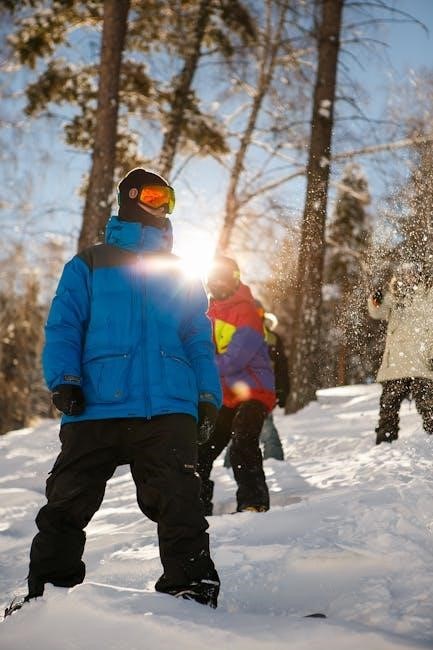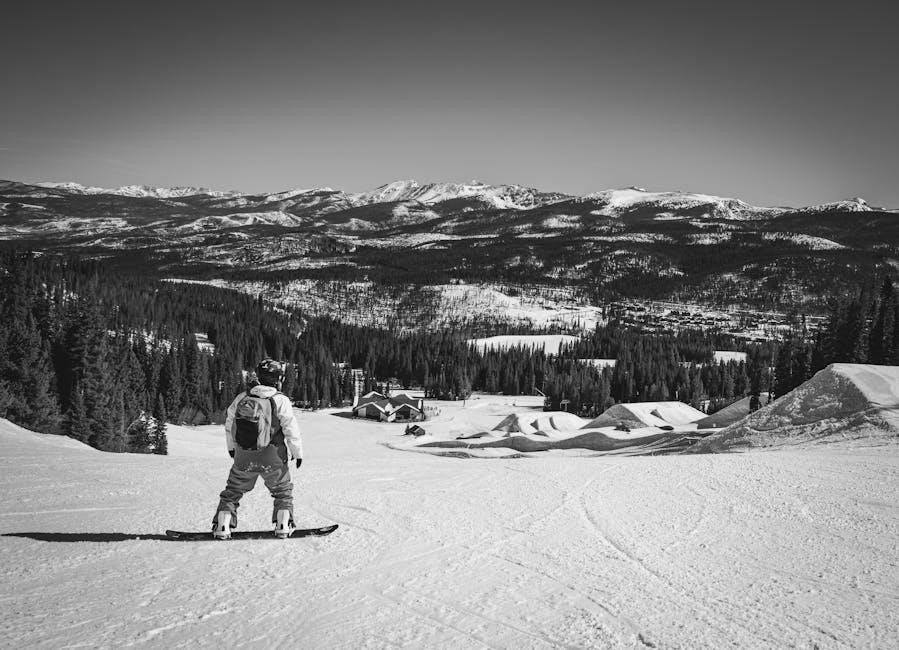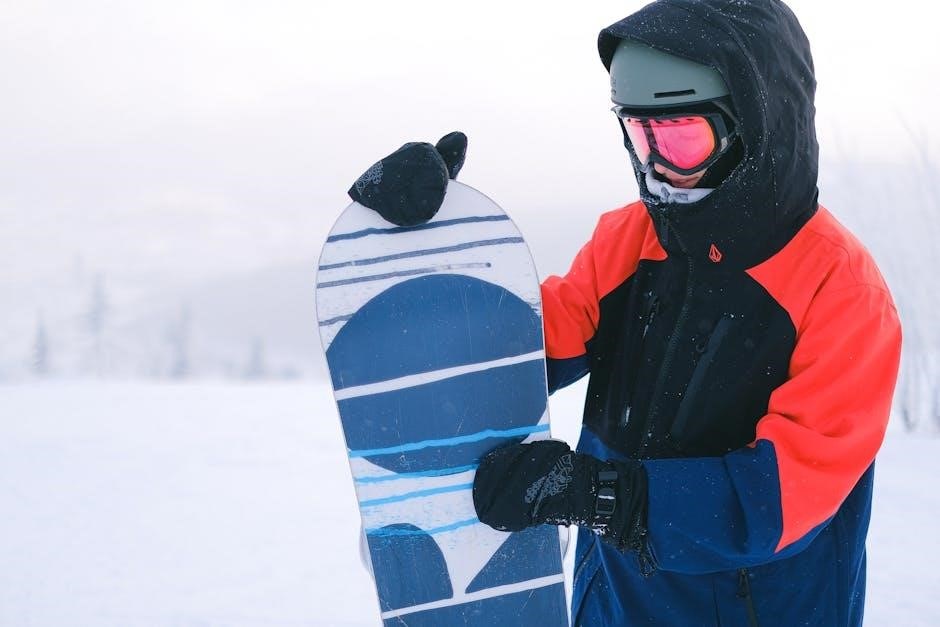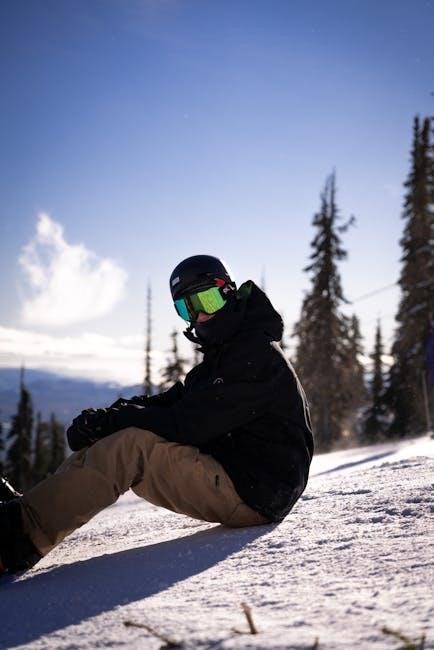Proper helmet sizing ensures safety, comfort, and performance. Measure your head circumference above the eyebrows and ears for an accurate fit. Sizes range from XS to 2XL.
1.1 Why Proper Helmet Size Matters
A properly sized helmet is essential for safety, comfort, and performance. A snug fit ensures optimal protection during impacts, reducing the risk of head injuries. Ill-fitting helmets can shift, compromising visibility and safety. A well-fitted helmet also enhances comfort, preventing pressure points and discomfort during long rides. Proper sizing ensures the helmet stays in place, allowing clear vision and mobility. Investing time in finding the right size is crucial for a safe and enjoyable snowboarding experience. Always prioritize a helmet that feels secure yet comfortable.
1.2 Overview of Helmet Sizing
Snowboard helmet sizing ranges from XS to 2XL, with each size corresponding to specific head circumferences. To determine your size, measure around the largest part of your head, just above the eyebrows and ears. Use a soft tape measure to ensure accuracy. Helmets are designed to fit snugly, providing protection without restricting movement. Proper sizing ensures optimal safety and comfort, making it essential to follow sizing charts and guidelines when selecting a helmet for snowboarding. Always refer to the manufacturer’s specific sizing chart for the best fit.
How to Measure Your Head for a Snowboard Helmet
Measure around the largest part of your head using a soft tape measure. Ensure the tape passes across the forehead, above the ears, and is level for accuracy.
2.1 Where to Measure Your Head
To accurately measure your head for a snowboard helmet, locate the largest circumference of your skull. Place the tape measure just above your eyebrows and ears, ensuring it is level and not too tight. This ensures the helmet will fit comfortably and provide proper protection. Measure over any hair to account for thickness. The tape should pass above the temples and around the back of your head, capturing the fullest part. This method works for most head shapes, whether rounded or elongated, and is applicable for both full-face and half-shell helmets. By following this guideline, you can determine your correct size effectively.
2.2 How to Use a Soft Tape Measure
To use a soft tape measure for helmet sizing, wrap it around the widest part of your head. Position the tape above your eyebrows and ears, ensuring it is snug but not tight. Keep the tape level and avoid twisting it. The tape should pass over any hair to account for thickness. Take note of the measurement in centimeters, as this will correspond to helmet size charts. For accuracy, measure twice and ensure the tape is not too loose or too tight. This method provides a reliable baseline for choosing the correct helmet size.
2.3 Ensuring Accurate Measurements
For accurate measurements, position the soft tape measure correctly above your eyebrows and ears, keeping it level and snug. Avoid pulling the tape too tight or leaving it too loose. Ensure the tape lies flat against your head without twisting. Take multiple measurements to confirm consistency. If possible, have someone assist you for precision. Measure with your hair as you normally wear it, as thickness can affect fit. A proper measurement ensures a helmet that is both safe and comfortable, fitting securely without pressure points.
2.4 Understanding Head Circumference
Head circumference is the measurement around the widest part of your head, typically just above your eyebrows and ears. It is crucial for determining the correct helmet size. To measure accurately, use a soft tape measure, ensuring it is level and not too tight or loose. Take multiple measurements to ensure consistency. This measurement will help you select a helmet that fits comfortably and provides optimal protection. Proper fit is essential for safety and performance while snowboarding.
Understanding Snowboard Helmet Size Charts
Size charts guide you in selecting the right helmet by correlating head circumference measurements with helmet sizes, ensuring a proper fit for safety and comfort.
3.1 Overview of Size Charts
Size charts are essential tools for determining the correct helmet fit. They typically range from XS to 2XL, correlating head circumference measurements in centimeters with corresponding sizes. For example, Small may cover 51-55cm, Medium 55-59cm, and so on. These charts help ensure the helmet fits snugly, providing optimal protection and comfort. Proper use of size charts guarantees a safe and enjoyable snowboarding experience by matching individual head measurements to the appropriate helmet size.
3.2 Typical Size Ranges (XS to 2XL)
Most snowboard helmets are available in sizes from XS to 2XL, catering to various head sizes. XS typically fits 48-53cm, S fits 53-56cm, M fits 56-59cm, L fits 59-62cm, and XL fits 62-64cm, with 2XL covering larger measurements. These ranges ensure a snug, comfortable fit for diverse head shapes. Proper sizing is critical for safety and comfort, so always refer to the specific brand’s size chart for accurate measurements and a secure fit tailored to your needs.
3.3 Size Comparisons Across Brands

Factors That Influence Helmet Size
Head shape, hair thickness, and adjustability features influence helmet size. Proper fit ensures safety and comfort. Measure accurately to match your head shape and preferences.
4.1 Head Shape and Contour
Head shape significantly impacts helmet fit. Round, oval, or elongated contours require specific designs. Helmets with adjustable features accommodate various shapes. Measure above eyebrows and ears for accuracy. Brands offer models catering to different head types, ensuring optimal comfort and safety. Testing the fit ensures proper alignment and coverage. Always consider contour fit for precise sizing. This ensures the helmet stays secure and comfortable during use.
4.2 Hair Thickness and Layering
Hair thickness and layering affect helmet fit. Thicker hair may require a larger size, while fine hair fits standard sizes. Adjustments can be made using fit systems. Layering hats or beanies under the helmet alters fit. Ensure the helmet remains snug and secure. Measure head circumference with hair as it will be worn. Proper fit ensures safety and comfort, regardless of hair thickness or style. Always test the fit with intended hair configuration for accuracy.
4.3 Adjustability Features
Adjustability features enhance fit customization. Helmets with adjustable dials or straps allow fine-tuning for comfort and security. These systems accommodate varying head shapes and sizes. Look for pads and liners that can be removed or adjusted to personalize fit. Some helmets offer Occigrips or similar technologies for precise adjustments. Ensure the helmet stays snug with these features. Adjustability ensures optimal fit, improving safety and comfort, especially with different hairstyles or layering. Proper use of these features maximizes helmet performance and wearer satisfaction on the slopes.
Choosing the Right Helmet Type
Full-face helmets offer maximum protection, while modular helmets provide versatility. Half-shell helmets balance style and breathability. Each type suits different riding styles and preferences.
5.1 Full-Face Helmets
Full-face helmets provide comprehensive protection, covering the entire head, including the back, ears, and face. They are made from durable plastics and advanced padding for maximum safety. Ideal for high-speed riding and harsh conditions, these helmets feature a visor to shield against snow and wind. While they offer superior protection, they are designed to be snug and breathable, ensuring comfort for all-day wear. Full-face helmets are a top choice for riders prioritizing safety and durability in extreme snowboarding environments.
5.2 Modular Helmets
Modular helmets combine the protection of full-face helmets with the breathability of open-face designs. They feature a detachable chin bar, allowing riders to switch between configurations. These helmets are ideal for versatility, offering enhanced protection during high-speed descents while remaining comfortable for casual rides. Adjustable visors and ventilation systems improve functionality, catering to riders who prioritize adaptability. Modular helmets are a great choice for those who enjoy both all-mountain and freestyle riding, providing a balance of safety and comfort in varying conditions.
5.3 Half-Shell Helmets
Half-shell helmets offer a lightweight, breathable option for snowboarders. They cover the top and back of the head, providing essential protection without full-face coverage. Ideal for casual riders, these helmets often feature removable earpads and adjustable fit systems for comfort. While they don’t offer the same level of protection as full-face helmets, half-shell designs are perfect for those prioritizing mobility and style. They are popular among park and all-mountain riders who value flexibility and a more relaxed fit.
When to Replace Your Snowboard Helmet
Replace your snowboard helmet if it shows visible damage, such as dents or cracks. Also, replace it after 3-5 years or if it fades significantly.
6.1 Signs of Wear and Tear
Inspect your helmet regularly for signs of wear and tear. Look for dents, cracks, or fading, which may indicate weakened structural integrity. Check the padding for compression or degradation, as this can compromise the fit. If the visor is scratched or the lining is worn, it may affect visibility and comfort. Any damage to the chin strap or buckles can also impact safety. These signs suggest it’s time to consider replacing your helmet to maintain optimal protection.
6.2 Impact Damage and Safety
A helmet that has suffered impact damage, even if minor, should be replaced immediately. Look for cracks, dents, or deformation in the shell or liner. Any compromise to the helmet’s structure can reduce its ability to protect your head in future impacts. If the helmet loses its shape or fit after a crash, it may no longer provide adequate safety. Always prioritize a new helmet if you suspect damage, as safety should never be compromised.
6.3 General Replacement Guidelines
Replace your snowboard helmet every 3-5 years, even if it appears undamaged. Over time, materials degrade, reducing safety effectiveness. If you’ve been in a crash, replace the helmet immediately. Always check for manufacturer expiration dates and guidelines. Look for visible signs of wear, such as cracks or fading. A new helmet ensures optimal protection and performance. Regular inspections and timely replacements are crucial for maintaining safety standards while snowboarding.

Safety Standards and Certifications
Helmets must meet safety standards like ASTM and CE certifications, ensuring impact protection and durability. These certifications guarantee helmets meet rigorous safety requirements for snowboarding.
7.1 ASTM and CE Certifications
ASTM (American Society for Testing and Materials) and CE (Conformité Européene) certifications ensure helmets meet rigorous safety standards. ASTM focuses on impact protection, penetration resistance, and retention strength, while CE certification verifies compliance with European safety regulations. These certifications involve testing helmets under various conditions to ensure they provide reliable protection for snowboarders. Always look for these certifications when selecting a helmet to guarantee safety and durability on the slopes.
7.2 What Safety Ratings Mean
Safety ratings indicate a helmet’s ability to protect against impacts. High ratings mean superior performance in absorbing shocks and distributing force. Ratings are determined through standardized tests, including drop tests and penetration tests. Helmets with higher ratings are recommended for high-speed or risky activities. Ensure your helmet has a reputable rating to maximize protection while snowboarding.
7.3 Importance of Certified Helmets
Certified helmets meet rigorous safety standards, ensuring reliable protection. Look for ASTM or CE certifications, which verify a helmet’s ability to absorb impact and protect against injuries. Non-certified helmets may fail in critical situations, risking your safety. Investing in a certified helmet minimizes risks and offers peace of mind, especially for high-speed or freestyle snowboarding.
Fit and Comfort
A proper fit ensures safety and comfort. Your helmet should feel snug but not tight, staying securely in place when moving. Adjustable straps and padding provide a custom fit.
8.1 How to Test the Fit
To ensure a proper fit, start by measuring your head circumference with a soft tape measure just above your eyebrows and ears. Match this measurement to the helmet’s size chart to select the appropriate size. Once the helmet is on, check that it sits level on your head, neither tilting back nor forward. Adjust the straps to form a ‘V’ around your ears, ensuring they are neither too tight nor too loose. Fasten the chin strap snugly, allowing one finger to fit comfortably underneath. Shake your head gently; the helmet should remain stable without shifting. If it moves excessively, it may be too loose. Finally, test the fit in various positions, such as bending over, to ensure the helmet stays securely in place. Proper fit ensures safety, comfort, and optimal protection while snowboarding.
8.2 Adjustability and Custom Fit
Ensure a custom fit by adjusting the helmet’s fit system, such as dial-adjustable fit systems or removable padding. Adjustable straps allow you to fine-tune the fit around your ears. Many helmets feature a ‘V’ shape strap system for optimal comfort. For a snug fit, the helmet should feel secure but not restrictive. Some helmets offer interchangeable liners or padding to accommodate different head shapes. Adjustability ensures the helmet stays in place during movement, providing consistent protection and comfort. Look for helmets with customizable features to achieve the perfect fit.
8.3 Comfort Features to Look For
Look for helmets with breathable ventilation systems to regulate temperature and prevent overheating. Removable and washable liners enhance comfort and hygiene. Padding with moisture-wicking fabric keeps your head dry. Some helmets feature adjustable visors for sun protection and goggle compatibility. Consider helmets with soft, ergonomic ear pads for added comfort. Integrated audio compatibility allows for seamless music integration without compromising fit. A well-ventilated, lightweight design ensures all-day comfort on the slopes. These features contribute to a more enjoyable snowboarding experience.

Troubleshooting Common Fit Issues
Address tightness by loosening the chin strap or adjusting padding. For a loose fit, tighten the strap or add thickness to the liner. Ensure proper alignment.
9.1 Helmets That Are Too Tight
A helmet that is too tight can cause discomfort or pain, especially during extended use. If your helmet feels constricting, try loosening the chin strap or adjusting the fit system. Removeable padding can be taken out to create more space. If the issue persists, consider a larger size. Ensuring a snug but not overly tight fit is crucial for both comfort and safety. A properly fitting helmet should stay in place without causing pressure points.
9.2 Helmets That Are Too Loose
A loose helmet can shift during activities, reducing its protective effectiveness. If your helmet feels unstable, tighten the chin strap or adjust the fit system. Adding thicker padding or liners can also improve the fit. Ensure the helmet sits level on your head and doesn’t tilt back. If adjustments don’t solve the issue, consider a smaller size. A properly fitted helmet should stay securely in place, providing reliable protection without compromising comfort or visibility.
9.3 Adjusting for Proper Fit
To achieve a proper fit, start by ensuring the helmet sits level on your head, just above the eyebrows. Adjust the fit using the chin strap and any internal dials or padding. The helmet should feel snug but not constricting. Shake your head gently to check stability—it should stay in place. If needed, add or remove padding to customize the fit. Proper adjustments ensure maximum safety and comfort, allowing you to focus on your snowboarding experience without distractions.
Maintaining Your Snowboard Helmet
Regularly clean your helmet with mild soap and water. Store it in a cool, dry place away from direct sunlight. Replace worn-out parts promptly.
10.1 Cleaning Your Helmet
Use a soft cloth and mild soap solution to gently wipe the exterior and interior of the helmet. Avoid harsh chemicals or abrasive materials that might damage the finish or harm the padding. For stubborn stains, lightly dampen the cloth but ensure no water seeps into the padding. Allow the helmet to air dry naturally after cleaning to prevent moisture buildup. Regular cleaning maintains hygiene and extends the helmet’s lifespan while keeping it looking fresh and ready for use.
10.2 Storing Your Helmet
Store your helmet in a cool, dry place away from direct sunlight to prevent fading and damage. Avoid stacking heavy objects on top of it, as this can cause compression or deformation. If possible, keep the helmet in its original case or a protective bag to shield it from dust and scratches. Remove any accessories like visors or liners and store them separately to maintain their shape. Proper storage ensures your helmet remains in optimal condition for future use.
10.3 Caring for the Visor and Lining
Regularly clean the visor using a soft cloth and mild soap to maintain visibility. Avoid harsh chemicals, as they can scratch or degrade the material. For removable liners, wash them with gentle detergent and allow them to air dry. Store the visor separately from the helmet to prevent scratches. Ensure the lining is completely dry before reinstallation to avoid mold or odor buildup. Proper care extends the lifespan and maintains the functionality of these essential components.
Picking the Best Helmet for Your Needs
Selecting the right helmet involves considering your riding style, terrain, and personal preferences. Ensure it meets safety standards and offers features like adjustability and comfort.
11.1 All-Mountain Helmets
All-mountain helmets are versatile and suitable for a variety of snowboarding conditions. They typically feature a balanced design, offering protection without compromising on style or comfort. These helmets are ideal for riders who explore different terrains, from groomed trails to backcountry adventures. Key features include durable construction, adjustable fit systems, and excellent ventilation to keep you cool during intense sessions. Ensuring a proper fit is crucial, so refer to size charts and try them on if possible. These helmets are a great choice for those seeking reliability and adaptability in their snowboarding gear.
11.2 Freestyle and Freeride Helmets
Freestyle and freeride helmets are designed for dynamic riding, offering lightweight, breathable designs. They prioritize flexibility and mobility, ideal for tricks and high-speed descents. These helmets often feature enhanced impact protection and durability, catering to aggressive riders. Freeride helmets may include additional coverage for added safety. Proper sizing is essential to maintain comfort and performance during intense maneuvers. Always ensure a snug, secure fit and check for certifications like ASTM or CE to guarantee safety standards are met for high-risk activities.
11.3 Racing and High-Speed Helmets
Racing and high-speed helmets are built for performance, featuring aerodynamic designs to reduce wind resistance. They often include reinforced structures for superior impact protection and advanced ventilation systems for breathability. These helmets are lightweight yet durable, ensuring optimal comfort during intense rides. When choosing a size, measure your head circumference accurately to ensure a snug, secure fit. Look for helmets with certifications like ASTM or CE, which meet rigorous safety standards for high-speed activities. Proper fit and safety features are crucial for racers and speed enthusiasts.



